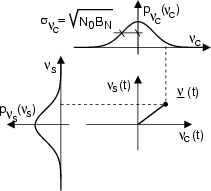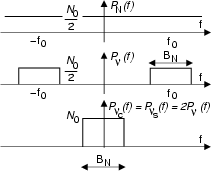



Ricordando ora i risultati ottenuti al § 8.4.2, nel caso in
cui il rumore
n![]() t
t![]() in ingresso a
HR
in ingresso a
HR![]() f
f![]() sia un processo ergodico bianco con densitÓ di potenza
sia un processo ergodico bianco con densitÓ di potenza
![]() n
n![]() f
f![]() =
= ![]() ,
e se il filtro di ricezione ha una risposta in frequenza unitaria a frequenza
portante, ossia
,
e se il filtro di ricezione ha una risposta in frequenza unitaria a frequenza
portante, ossia
![]() HR
HR![]() f0
f0![]()
![]() = 1, allora
si ottiene che
= 1, allora
si ottiene che
![]()
![]() t
t![]() e
e
![]()
![]() t
t![]() risultano essere due processi congiuntamente gaussiani, ergodici, a media nulla
ed uguale varianza (e potenza)
risultano essere due processi congiuntamente gaussiani, ergodici, a media nulla
ed uguale varianza (e potenza)
Pertanto, nel caso in cui si operi una demodulazione coerente in fase ed in
quadratura del segnale ricevuto, nelle componenti analogiche risultanti saranno
presenti i termini additivi
![]()
![]() t
t![]() e
e
![]()
![]() t
t![]() ,
entrambi di potenza
,
entrambi di potenza
![]()
![]() = N0BN.
= N0BN.